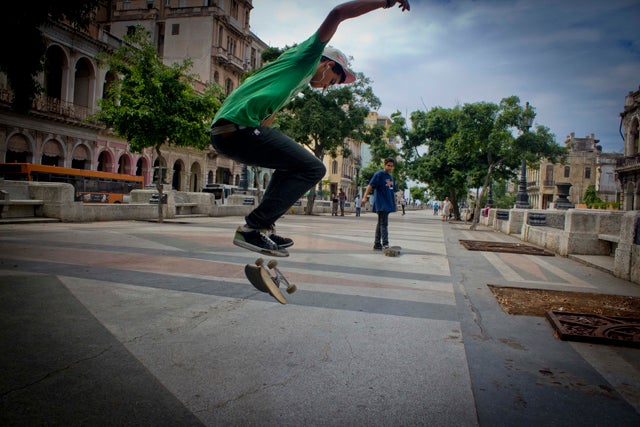Traffic is a playground. Darting between smog-choked ’58 Chevys, Havana’s sidewalk surfers appear both fluid and elusive, emerging long enough for passersby to catch a glimpse before dissipating into waves of afternoon haze.
But, in the land of baseball, rum, and Castro (in that order), spotting these once mercurial figures is no longer as hard as it used to be. There are more than ever, attached to four wheels that clatter over rutted pavement and ruptured sidewalks. They are faces of a sport on the rise, the newest generation of Cuban skateboarders.
Skateboarding has been in Cuba for over three decades, but it has remained underground until very recently, due in part to the political climate of the ‘80s and ‘90s. Around the world the sport has always represented a level of social rebellion, an attitude not tolerated during an era that saw Castro tighten his political grip to keep his nation afloat. This was the atmosphere when Che Alejandro Pando Napoles began skateboarding at age 10.
“I’ve been skating for 30 years,” says Napoles, a popular Havana tattoo artist considered one of the founding members of skating in Cuba. “In the beginning it was very difficult [because] there weren’t many materials…. No one had anything to skate with so they’d invent things—boards, wheels, those things.”
Slowly these little ingenuities birthed a small skate culture, and skaters like Che, as his boarding brethren know him, took to the streets of Havana. They adopted the mantra, “Patinar o Muerte” (skate or die)—a clever play on Che Guevara’s famous call, “Patria o Muerte” (homeland or death)—and started hitting small ledges, stair sets, and concrete structures around the city, and trying their hands at amateur filming. Welcoming anyone wanting to skate, the pack frequented a public square that featured three small ledges and some park benches. The spot, at the corner of the capital city’s 23 and G avenues, became a gathering spot for skaters and the namesake for Che’s “23 y G” posse.
“I began skating because one day I came here to 23 and G and I saw a lot of people skating, Che … and others,” says “23 y G” member Carlos Yandri, 17. “I liked it, and ever since, skating has been part of my life.”
With the influence of the “23 y G” squad, the sport continued to gain a foothold on the island, and in the mid-2000s the crew built a skate park in Havana, the first in all of Cuba. Though it could hardly be considered anything beyond graffiti on concrete with a few handrails and ramps, the park represented a step forward for a community that for many years had been invisible.
“I like to go to the [skate] park with my friends,” says skater Orlando Rosales. “[We] share tricks and skate styles with each other.”
But despite the increased interest, the most daunting fact remains: Cubans have no domestic access to skate gear. While at first glance skaters dress and act much like their American and European counterparts, a closer look reveals ripped, blown-out footwear and boards sporting fault-line cracks patched with old bumper stickers. Some forego footwear altogether, sacrificing comfort for a little grip.
The recent relaxation of borders and influx of tourists has helped the situation, bringing in a slow trickle of skate supplies from the outside world, but Che describes the aid as, “just a small drop in a big ocean.”
Organizations like American-born Cuba Skate, which has recently folded back into its parent organization, , and private contributors like pro skaters Ryan Sheckler and Bob Burnquist among others, have landed boards and supplies in Cuba, but the process is difficult. According to Che, packages must be small to get through strict Cuban customs offices, so there is no chance of delivering the mass supply of goods needed by skaters in the Caribbean nation.
Still, the sport has made inroads on the island. For one, it no longer sits in the shadows. The skate culture is young, vibrant and full of energy. In many ways skaters embody the Cuban mentality: adapting to less-than-ideal conditions, skating on whatever they have, wherever they can.
“SK8,” as it’s commonly referenced, has become engrained in the nation’s sport culture, a necessary positive for the sport’s survival into the future. For many, including “23 y G” videographer Robert Gomez, a university student, skating is more than just a pastime. “If I didn’t skate,” he says, “I really don’t know what I’d do.”


